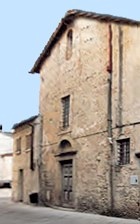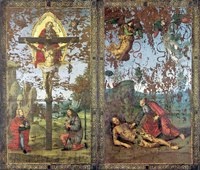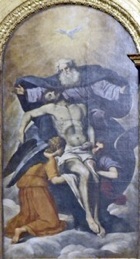


This confraternity had its original church on the opposite side of Via della Fraternita.
In 1458, Bishop Ridolfo secured the approval of Pope Callistus III for an exchange of properties with the nuns of the adjacent Monastero del Paradiso: the fraternity transferred to the nuns their original church and other property and, in return, Bishop Ridolfo gave them the nearby church of Santa Maria del Vingone (1350) over which he had had commendatory rights.
The brothers essentially rebuilt this church, changing its orientation so that its facade was in Via della Fraternita. The choir was rebuilt in 1682 to a design by Nicolò Barbiani, and the vaults were rebuilt in 1706. The ex-church is now private property.
Art from the Church
Gonfalone della Santissima Trinità (ca. 1503)

This two-sided processional banner was probably commissioned by the Confraternita della Trinità, which met in SS Trinità. It was first documented there in 1627, with an attribution to Raphael, and again a year later, when it was deemed to be too damaged to be used in processions. The two sides were subsequently separated and were used as altarpieces at the sides of the high altar of the church until 1855, when they suffered the first of a series of attempted restorations. The most recent of these, in 1952 and 1983, were of very high standard, but much of the damage could not be reversed. The panels passed to the Commune in 1860 and are now in the Pinacoteca Comunale.
The panels depict:
-
✴Holy Trinity (God the Father, the Crucified Christ and a dove representing the Holy Spirit) with SS Sebastian and Roch; and
-
✴the creation of Eve from Adam’s rib, with two angels.
Each retains its original gilded border.
A preparatory sketch for the figure of God the Father in the panel on the right survives in the Ashmolean Museum, Oxford. The same sheet contains a sketch of a detail of the altarpiece (1498) of the Martyrdom of St Sebastian by Luca Signorelli in San Domenico, Città di Castello, to which Raphael’s Mond Crucifixion (1503 - see below) formed a pendant. Raphael presumably executed these sketches while he was in San Domenico in order to plan his design for the altarpiece, which suggests that the banner was also painted in ca. 1503.
Trinity (1639)


